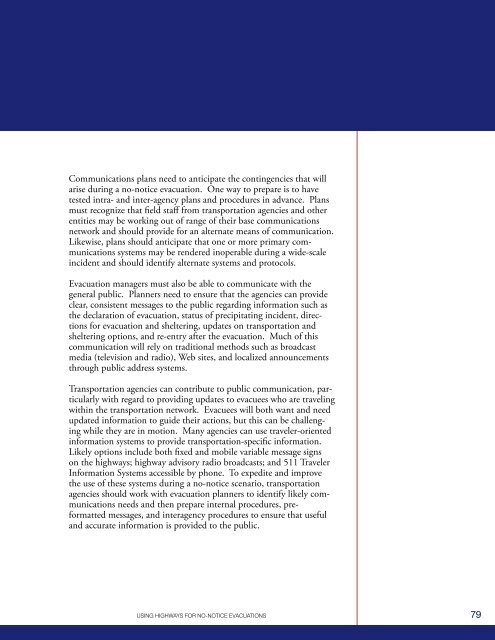using highways for no-notice evacuations - FHWA Operations - U.S. ...
using highways for no-notice evacuations - FHWA Operations - U.S. ...
using highways for no-notice evacuations - FHWA Operations - U.S. ...
You also want an ePaper? Increase the reach of your titles
YUMPU automatically turns print PDFs into web optimized ePapers that Google loves.
Communications plans need to anticipate the contingencies that willarise during a <strong>no</strong>-<strong>no</strong>tice evacuation. One way to prepare is to havetested intra- and inter-agency plans and procedures in advance. Plansmust recognize that field staff from transportation agencies and otherentities may be working out of range of their base communicationsnetwork and should provide <strong>for</strong> an alternate means of communication.Likewise, plans should anticipate that one or more primary communicationssystems may be rendered i<strong>no</strong>perable during a wide-scaleincident and should identify alternate systems and protocols.Evacuation managers must also be able to communicate with thegeneral public. Planners need to ensure that the agencies can provideclear, consistent messages to the public regarding in<strong>for</strong>mation such asthe declaration of evacuation, status of precipitating incident, directions<strong>for</strong> evacuation and sheltering, updates on transportation andsheltering options, and re-entry after the evacuation. Much of thiscommunication will rely on traditional methods such as broadcastmedia (television and radio), Web sites, and localized an<strong>no</strong>uncementsthrough public address systems.Transportation agencies can contribute to public communication, particularlywith regard to providing updates to evacuees who are travelingwithin the transportation network. Evacuees will both want and needupdated in<strong>for</strong>mation to guide their actions, but this can be challengingwhile they are in motion. Many agencies can use traveler-orientedin<strong>for</strong>mation systems to provide transportation-specific in<strong>for</strong>mation.Likely options include both fixed and mobile variable message signson the <strong>highways</strong>; highway advisory radio broadcasts; and 511 TravelerIn<strong>for</strong>mation Systems accessible by phone. To expedite and improvethe use of these systems during a <strong>no</strong>-<strong>no</strong>tice scenario, transportationagencies should work with evacuation planners to identify likely communicationsneeds and then prepare internal procedures, pre<strong>for</strong>mattedmessages, and interagency procedures to ensure that usefuland accurate in<strong>for</strong>mation is provided to the public.USING HIGHWAYS FOR NO-NOTICE EVACUATIONS79
















